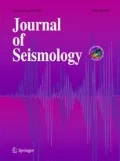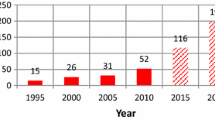Abstract
The engineering community is aware of the importance of site effects, but it lags behind seismological studies when it comes to incorporating site effect considerations in design spectra for seismic norms. This lag is reflected in the conspicuous fact that current building codes make allowance for 1D site effects but ignore complex site effects. The purpose of this paper is to explore a way for including complex site effects in a building code environment. We take as example Eurocode 8, which is a modern code that exemplifies the current approach to site effect consideration. We examine the restrictions that we have imposed to make the problem of a feasible size and discuss the approach we have taken. We propose a strategy to incorporate a class of complex site effects in a design elastic spectrum.
Similar content being viewed by others
References
Aki, K., 1993, Local site effects on weak and strong ground motion, Tectonophysics 218, 93–111.
Aki, K. and Larner, K.L., 1970, Surface motion of a layered medium having an irregular interface due to incident plane SH waves, J. Geophys. Res. 75, 933–954.
Bard, P.-Y., 1994, Effects of surface geology on ground motion: recent results and remaining issues, Proc. 10th European Conf. on Earthq. Engng. Vienna 1, 305–323.
Bard, P.-Y. and Bouchon, M., 1980a, The seismic response of sediment-filled valleys. Part 1. The case of incident SH waves, Bull. Seism. Soc. Am. 70, 1263–1286.
Bard, P.-Y. and Bouchon, M., 1980b, The seismic response of sediment-filled valleys. Part 2. The case of incident P and SV waves, Bull. Seism. Soc. Am. 70, 1921–1941.
Bard, P.-Y. and Bouchon, M., 1985, The two-dimensional resonance of sediment filled valleys, Bull. Seism. Soc. Am. 75, 519–541.
Bard, P.-Y. and Gariel, J.C., 1986, The seismic response of twodimensional sedimentary deposits with large vertical velocity gradients, Bull. Seism. Soc. Am. 76, 343–366.
Borcherdt, R.D., 1994, Estimates of site dependent response spectra for design (methodology and justification), Earthquake Spectra 10, 617–653.
Davidovici, V.E., 1996, New trends of Eurocode8/General rules, Proc. 11th World Conf. Earthq. Engng., Acapulco, 23–28 June, Elsevier Science Ltd. CDROM, paper 2157, 5 pp.
Eurocode 8, 1994, Design provisions for earthquake resistance of structures – Part 1–1: General rules – Seismic actions and general requirements for structures. ENV 1998–1–1, CEN European Committee for Standardization, May, Brussels.
Faccioli, E., 1991, Seismic amplification in the presence of geological and topographic irregularities, Proc. 2nd Intern. Conf. On Recent Advances in Geotechnical Earthq. Engng., St. Louis (Missouri), State-of-art paper, pp. 1779–1797.
Faccioli, E., 1996a, On the use of engineering seismology tools in ground shaking scenarios, Proc. 11th World Conf. Earthq. Engng., Acapulco, 23–28 June, Elsevier Science Ltd. CDROM, paper 2007.
Faccioli, E., 1996b, Site effects in the Eurocode 8, Proc. 11th World Conf. Earthq. Engng., Acapulco, 23–28 June, Elsevier Science Ltd. CDROM, paper 2043.
Gazetas, G., 1997, Contribution of National Technical University of Athens (Soil Mechanics and Soil Dynamics Laboratory). In E. Faccioli (ed), TRISEE – 3D Site Effects and Soil-Foundation Interaction in Earthquake and Vibration Risk Evaluation – First year Project report to the European Commission, Environment and Climate Programme, Milan, Italy, March.
Jiang, T. and Kuribayashi, E., 1988, The three-dimensional resonance of axisymmetric sediment-filled valeys, Soils and Foundations 28, 130–146.
Martin, G.R. and Dobry, R., 1994, Earthquake site response and seismic code provisions, NCEER Bull. 8, 1–6.
Moczo, P. and Bard, P.-Y., 1993, Wave diffraction, amplification and differential motion near strong lateral discontinuities, Bull. Seism. Soc. Am. 83, 85–106.
Moczo, P., Labák, P., Kristek, J. and Hron, F., 1996, Amplification and differential motion due to an antiplane 2D resonance in the sediment valleys embedded in a layer over the half-space, Bull. Seism. Soc. Am. 86, 1434–1446.
Okawa, I., Shibuya, J., Yamada, M., Hagio, K. and Tohdo, M., 1996, An evaluation of local site effects on strong ground motion considering microlandforms and deep subsurface structure, Proc. 11th World Conf. Earthq. Engng., Acapulco, 23–28 June, Elsevier Science Ltd. CDROM, paper 1788.
Raptakis, D., Theodulidis, N. and Pitilakis, K., 1998, Data analysis of the Euroseistest strong motion array in Volvi (Greece): standard and horizontal-to-vertical spectral ratio techniques, Earthquake Spectra 14, 203–224.
Rassem, M., Ghobarah, A. and Heidebrecht, A.C., 1997, Engineering perspective for the seismic response of alluvial valleys, Earthq. Engng. Struct. Dyn. 26, 477–493.
Rinne, E.E., 1994, Development of new site coefficients for building codes, Proc. 5th Natl. Conf. on Earthq. Engng. III, Chicago, U.S.A, pp. 69–78.
Author information
Authors and Affiliations
Rights and permissions
About this article
Cite this article
Chávez-García, F.J., Faccioli, E. Complex site effects and building codes: Making the leap. Journal of Seismology 4, 23–40 (2000). https://doi.org/10.1023/A:1009830201929
Issue Date:
DOI: https://doi.org/10.1023/A:1009830201929




